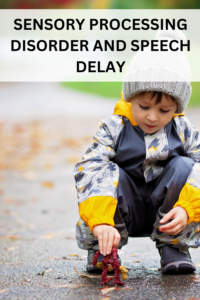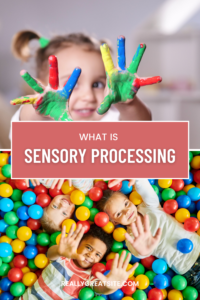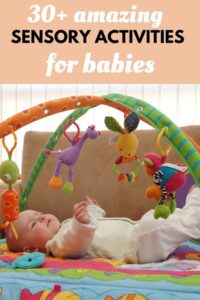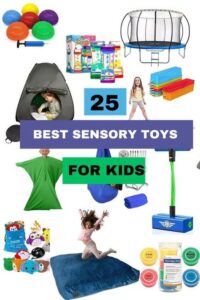
Nurturing Communication: Understanding the Deep Connection Between Sensory Processing Disorder and Speech Delay in Young Children
Sensory Processing Disorder and speech delay significantly impacts many children’s daily lives. It involves challenges in processing and responding to sensory information from the environment and communicating needs.
Children with Sensory Processing Disorder may have heightened or diminished responses to sensory input, leading to difficulties in regulating emotions, attention, and behavior.
As we navigate through this exploration, it is crucial to understand the various ways Sensory Processing Disorder and speech delay are connected.

Hi! My name is Marra and I’m a mama and a pediatric occupational therapist who has years of experience working with children with Sensory Processing Disorder and helping their parents navigate the ups and downs of child development.
I loved being a support person for parents learning about sensory processing, Sensory Processing Disorder and speech delay, and their child’s individual needs.
I would often recommend to families strategies and tools to help improve their child’s sensory processing and developmental skills. Many of the children I worked with had both Sensory Processing Disorder and speech delay.
This post is about the link between Sensory Processing Disorder and speech delay. We’ll discuss how closely related they are as well as strategies you can use to help.
What is Sensory Processing?
Before delving into Sensory Processing Disorder and speech delay,, let’s enhance our comprehension of sensory processing. Our sensory system plays a crucial role in how we perceive and react to the world around us.
Sensory processing refers to our capacity to absorb information from our surroundings, sift through relevant details, comprehend it, and select an appropriate response to the sensory input.
We have eight sensory systems for receiving input from our environment. The familiar five senses include sight, hearing, smell, taste, and touch.
In addition, there are three lesser-known sensory systems: vestibular, proprioceptive, and interoception. The vestibular sense relates to our perception of gravity and our body’s response to it.
Proprioception involves our awareness of deep pressure and body positioning. Interoception is our sense of how our body is feeling.
For a deeper understanding of sensory processing, feel free to explore the linked blog below.

Understanding Sensory Processing Disorder
Sensory Processing Disorder is a complex condition that impacts a child’s daily routine. It involves challenges in processing and responding to sensory information from the environment.
Children with SPD may have heightened or diminished responses to sensory input, leadng to difficulties in regulating emotions, attention, and behavior.
As we navigate through this exploration, it is crucial to understand the relationship between Sensory Processing Disorder and speech delay in children.

The relationship between sensory processing disorder and Speech Delay
Now that we have a better understanding of sensory processing, let’s look more closely at the relationship between Sensory Processing Disorder and speech delay.
Why do so many little ones with sensory difficulties have a delays in speech development? Well these two developmental skills are so closely related.
As discussed above, I like to think about sensory processing as a 3 step process:
- ,Step 1: Sensory information comes into our brain through our 8 sensory systems
- Step 2: We process the information, filter through it, choose what to attend to, what to ignore, and understand it.
- Step 3: Our response to the input, behavior, decisions, reactions, emotions, speech, actions, and so on.
So our speech and communication occur during step 3. This means that if a child has difficulty with step 1 (sensory input) or step 2 (processing the input) than they most likely will have difficulty with step 3 (speech).
A child needs to develop the skills to process sensory information at a certain level before they develop the ability to talk. This is one of the reasons we don’t typically hear words from children less than 1 year. They are still trying to figure out how to process everything.

The 3 primary sensory systems
It is important to understand the 3 primary sensory systems and their impact on sensory processing disorder and speech delay. The 3 primary sensory systems are:
- Tactile (touch)
- Vestibular (movement)
- Proprioception (deep pressure )
These are the first sensory systems to develop and begin before we are born. If you think about it, babies in utero don’t see, smell, or taste, but they are in constant movement, compressed in the fetal position, and in constant touch with their mom.
These are the 3 sensory systems you should and most likely pay the most attention to with a new born baby
- Tactile: Skim to skin is so important for newborns. Touch makes babies feel safe. Babies want to be held all the time and sleep better when they’re in your arms. This is an appropriate need and should be met.
- Vestibular: Babies love to move! Walk with them, bounce them, rock them, dance with them. They love it!
- Proprioceptive: Babies love that deep pressure input because it calms them. Swaddle baby, hug baby, hold baby, wrap baby in blankets, hats + socks. All forms of deep pressure
The other sensory systems should be very mellow in the newborn’s environment. Dimmer lights, soft sounds, and not focused on smell or taste yet. Chance are you did all of these sensory habits without even knowing why. It’s natural and intuitive for parents.
Side note–when I had my baby I made my nurses in the hospital laugh (and probably drove them a little crazy) because I was so picky about the amount of lights on and the type of lights used in my room.

Occupational Therapy for sensory processing disorder
These 3 primary sensory systems (tactile, vestibular, and proprioceptive) are also the first I target when providing sensory integration therapy to a child with sensory processing disorder.
Occupational therapists are healthcare professionals who specialize in sensory processing and sensory integration therapy. When working with a child with sensory needs, I first assess these 3 sensory systems and target them in therapy.
Not only are these 3 sensory systems the first to develop, but they support the development of the other sensory systems. Once children develop skills with processing tactile, vestibular, and proprioceptive sensory input, we can target others, such as hearing or auditory, and work on integration.
Typically when I work with a child with sensory processing disorder and speech delay, once they improve their regulation and sensory processing skills, they begin to use more words.
If your child has a sensory processing disorder or sensory needs and are not working with an occupational therapist, I strongly suggest consulting with one and looking into an OT evaluation. Check out the link below for more information,

Additional reasons Sensory Processing Disorder and Speech Delay are related
1. Sensory Overload and Communication
Children with sensory processing disorder and speech delay often experience sensory overload, making it challenging for them to focus on developing communication skills.
Certain input in their environment, such as loud noises, rough textures, or bright lights, can overwhelm children and divert their attention away from language acquisition. Recognizing and addressing your child’s specific sensory triggers is vital in creating an environment that nurtures their communication development.
2. Motor Planning and Speech Production
Sensory processing disorder can impact a child’s motor planning abilities, which are crucial for coordinating the complex movements required for speech production.
Motor skills involved in mouth and tongue movements may be particularly challenging for children with sensory difficulties. This can manifest as articulation issues, difficulty forming sounds, and overall challenges in expressing themselves verbally.
Recognizing signs of speech delay
1. Limited Vocabulary
Children with sensory processing disorder may exhibit a limited vocabulary compared to their peers. They might struggle to express themselves verbally and may resort to non-verbal communication methods, such as gestures or pointing.
Understanding and acknowledging these challenges is the first step in addressing and supporting your child’s communication needs.
2. Difficulty with Pronunciation
Speech delays in children with sensory processing disorder may manifest in difficulty pronouncing certain sounds or forming words correctly.
These challenges can be directly linked to sensory difficulties affecting oral motor skills. Recognizing these pronunciation struggles early on can guide interventions tailored to your child’s specific needs.
3. Social Communication Challenges
Sensory processing disorder can impact a child’s ability to engage in social interactions effectively. Speech delays may contribute to difficulties in initiating and maintaining conversations, potentially leading to social isolation. Identifying these challenges allows parents to implement targeted strategies to enhance their child’s social communication skills.

STRATEGIES FOR SUPPORTING SPEECH DEVELOPMENT
1. Create a Sensory-Friendly Environment
Identifying and addressing sensory triggers in your child’s environment is a continuous process. Make thoughtful adjustments to reduce sensory overload, such as using soft lighting, minimizing background noise, and providing comfortable clothing.
Creating a sensory-friendly space at home fosters an environment that supports your child’s overall development.
2. Incorporate Sensory Activities
Engage your child in a variety of sensory activities designed to promote communication. Activities such as finger painting, playing with textured materials, or sensory play can stimulate their senses and create a positive association with communication.
These activities not only enhance sensory processing but also contribute to the development of language skills.
3. Speech Therapy
Seeking professional help from a speech therapist is a crucial step in addressing speech delays. A speech therapist can conduct assessments to identify specific challenges and tailor interventions to your child’s unique needs.
Integrating sensory strategies into speech therapy sessions enhances the effectiveness of interventions and supports overall communication development.
4. Consistent Communication Strategies
Establishing consistent communication routines at home is key to supporting your child’s language development. Utilize visual aids, gestures, and simple language to enhance their understanding.
Patience and positive reinforcement play a significant role in encouraging your child’s communication efforts and building their confidence in expressing themselves verbally.
V. Collaborative Approach: Working with Professionals
A collaborative approach involving occupational therapists, speech therapists, educators, and other healthcare professionals is essential for providing comprehensive support to children with both sensory processing disorder and speech delay.
This multidisciplinary approach ensures a holistic understanding of your child’s needs and addresses both sensory and communication challenges. Regular communication and coordination among professionals contribute to a unified strategy focused on your child’s overall well-being.
Navigating the journey of parenting a child with sensory processing disorder and speech delay requires a deep understanding of the intricacies involved.
By unraveling the complex relationship between sensory processing disorder and speech delay and exploring additional dimensions, parents can take proactive steps to create a nurturing environment for their child’s communication development.
Remember, every child is unique, and with the right strategies, patience, and collaborative support, you can empower your little one to find their voice, overcome challenges, and thrive in their communication journey.
